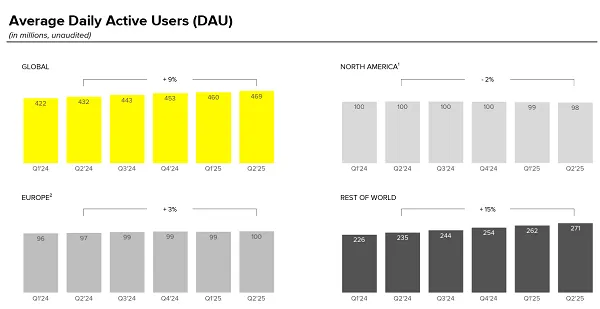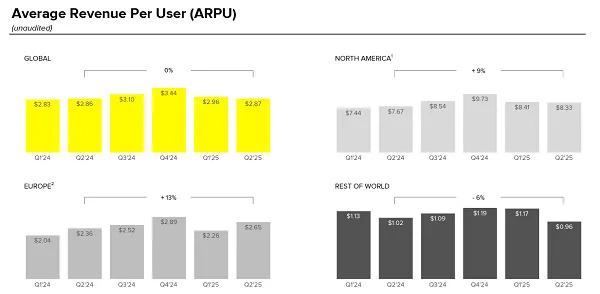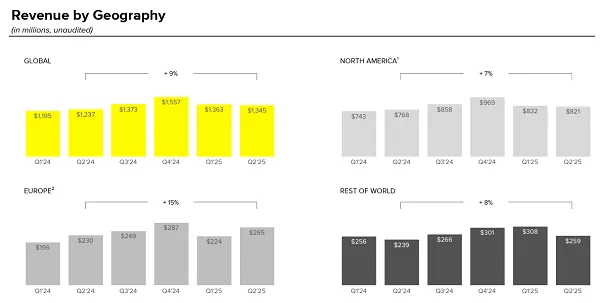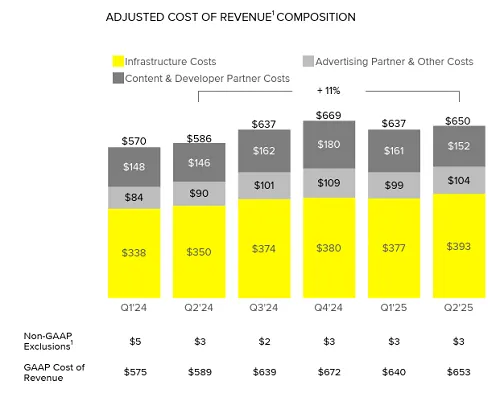Snapchat has printed its newest efficiency report, which, within the topline outcomes no less than, reveals regular will increase in customers and income, because it continues to refine its enterprise choices, and capitalize on its market alternatives.
Although progress in key markets stays a problem, with Snap persevering with to lose customers within the North American market, its key income supply, whereas rising prices additionally proceed to weigh on its general outcomes.
And its income outcomes are additionally not nice.
First off, on customers. Snapchat reached 469 million day by day energetic customers in Q2, a rise of 9 million on its Q1 numbers.

Once more, any progress is a constructive, however the truth that Snap is dropping customers within the U.S. is a standout be aware from this chart. Nearly all of Snap’s progress remains to be coming from the “Remainder of World” class, with India particularly seeing extra take-up. However the U.S. and EU is the place Snap generates nearly all of its income, and as such, the stagnant outcomes listed below are probably problematic.

As you possibly can see in these charts, Snap generates virtually 4x extra income per person from its North American viewers, and 800% greater than these within the “Remainder of World” phase.
Constructing in additional markets clearly bodes properly for future alternatives, as these areas proceed to develop their digital economies. However the regular decline of Snap utilization within the U.S. factors to a plateau, and a possible cap on Snap’s progress.
However in fact, Snap’s eager to deal with the positives, with the platform additionally inching nearer to a billion month-to-month actives, with 932 million month-to-month energetic customers (MAU), a rise of 32 million on Q1.
And general, the truth that Snap remains to be including tens of millions extra customers is an indicator of its enduring relevance and resonance, significantly amongst youthful customers.
We’ll see how the market responds to such.
On the income entrance, Snap introduced in $1.3 billion for the quarter, a rise of 9% year-over-year.

However once more, you possibly can see the influence of its U.S. viewers decline right here, with its North American income down on Q1, whereas it’s additionally posted its lowest income lead to 4 quarters.
And whereas Snap is targeted on its next-level bets, like AR glasses, it must preserve producing income to maximise this component, and the chart traits right here don’t look nice.
Together with this one:

When it comes to particular enterprise choices, Snap says that it’s seeing good outcomes with Sponsored Snaps, which are actually driving an 18% carry in distinctive conversions throughout app installs and app purchases.
Snap says that it’s additionally seeing extra engagement with its Highlight short-form video providing, with time spent within the Highlight feed rising 23% year-over-year, facilitating extra publicity choices. Certainly, Snap says that Highlight now contributes greater than 40% of whole content material time spent within the app, which might be price noting to your video advertisements.
Snap’s additionally been working to combine extra creator content material, through its Snap Stars program, with the variety of Highlight posts by Snap Stars rising greater than 145% year-over-year in North America in Q2.
So there are, no less than in idea, alternatives there, and if Snap can facilitate extra model partnerships, resulting in creator monetization and elevated publicity potential for manufacturers, there’ll nonetheless be worth on this entrance, even when general utilization dips.
Snap additionally notes that use of its Snap Map has grown to greater than 400 million MAU, and with expanded promotional choices being built-in right here, that might be one other space of alternative.
However it’s Snapchat’s AR mission, and the prices related to it, that stay some extent of competition.
Again in June, Snapchat introduced that it’ll launch its AR-enabled Spectacles subsequent 12 months, in an effort to beat Meta to market with a purposeful, trendy AR system.
Which is sensible, as the symptoms are that Meta’s glasses will probably be extra purposeful, trendy and cheaper, however the price of that mission is probably going a major contributor to Snap’s growing infrastructure prices, together with its personal AI initiatives.
However Snap’s not constructing its personal AI instruments, it’s principally internet hosting AI experiences from OpenAI and Google, with the intention to energy issues like its “My AI” chatbot. As such, nearly all of its prices would seemingly be going in direction of this AR glasses push, which is sensible within the broader scale of Snap’s long-term plan.
However in observe, it looks as if this might be a catastrophe for the enterprise.
Positive, Snap customers are nonetheless curious about AR, with Snap reporting that greater than 350 million Snapchatters now interact with its AR instruments daily, and Snap continues so as to add extra modern AR makes use of, like its current integration with a TV present within the U.Okay.
However will additionally they purchase Snap’s AR glasses, and in the event that they do, will Snap be capable of preserve momentum for resembling Meta continues to inch nearer to a launch of its AR system.
I don’t assume that this can be a race Snap can win, and Snap could be higher off creating AR experiences for different gadgets, versus investing in its personal, which is trying like a significant money drain, for what could be solely a short-term increase in curiosity.
Snap’s internet loss for Q2 was $263 million, in comparison with $249 million within the prior 12 months. And because the prices proceed to rise, and person progress stays a query, this looks as if an enormous level of concern for the app.



